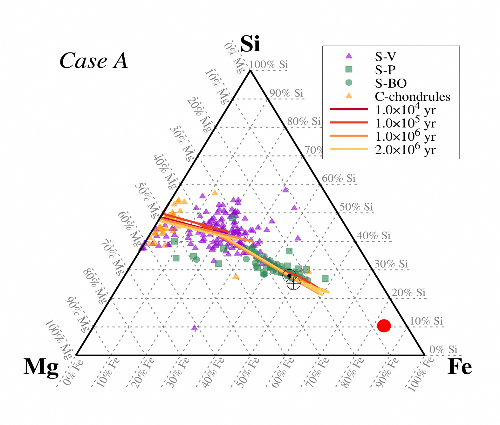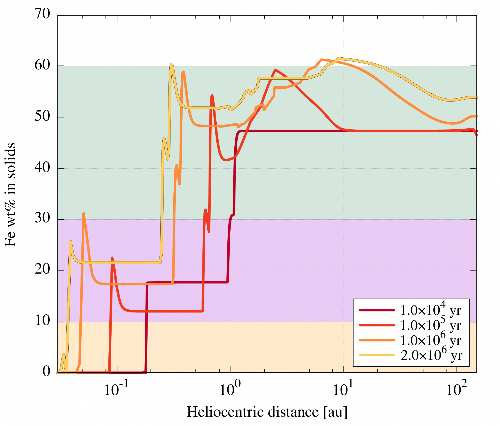- 1Laboratoire d'Astrophysique de Marseille, Aix-Marseille Université, Marseille, France (artem.aguichine@lam.fr)
- 2Laboratoire d'Astrophysique de Marseille, Aix-Marseille Université, Marseille, France (olivier.mousis@lam.fr)
- 3CEREGE, Aix-Marseille Université, Aix-en-Provence, France (devouard@cerege.fr)
- 4Lund Observatory, Lund University, Lund, Sweden (thomas.ronnet@astro.lu.se)
In our solar system, terrestrial planets and meteoritical matter exhibit various bulk compositions. To understand this variety of compositions, formation mechanisms of meteorites are usually investigated via a thermodynamic approach that neglects the processes of transport throughout the protosolar nebula. Here, we investigate the role played by rocklines (condensation/sublimation lines of refractory materials) in the innermost regions of the protosolar nebula (PSN) to compute the composition of particles migrating inward as a function of time. To do so, we utilize a one-dimensional accretion disk model with a prescription for dust and vapor transport, sublimation, and recondensation of refractory materials [1]. Figure 1 shows the computed composition of the PSN in the Mg-Fe-Si ternary diagram, and Figure 2 shows the same profiles but where we represent the Fe wt% as a function of heliocentric distance. We find that the diversity of the bulk composition of cosmic spherules, chondrules, and chondrites can be explained by their formation close to rocklines. This suggests that solid matter is concentrated in the vicinity of these sublimation/condensation fronts. Although our model only focuses on the most abundant refractory species (ferrosilite, enstatite, fayalite, forsterite, iron sulfide, kamacite, nickel) and relevant thermodynamic data, it suggests that rocklines played a major role in the formation of small and large bodies in the innermost regions of the protosolar nebula. The increase in iron abundance close to iron alloys rocklines gives some hints on the origin of dust particles that formed Mercury’s large core.

Figure 1. Composition profiles of the PSN in a Mg-Fe-Si ternary diagram (expressed in mass fraction) at different times, with composition of glass cosmic spherules (S–V type), barred olivine spherules (S-BO type), porphyritic spherules (S-P type) and C-chondrules. Protosolar and Earth’s compositions are represented by Sun’s and Earth’s symbols, respectively, and Mercury’s composition is represented by a red circle.

Figure 2. Same as Figure 1, but here the Fe wt% is represented as a function of heliocentric distance. Color boxes correspond to typical compositions of chondrules (0%–10%), glass cosmic spherules (10%–30%), and porphyritic and barred olivine cosmic spherules (30%–60%).
[1] Aguichine, A., Mousis, O., Devouard, B., and Ronnet, T. 2020, ApJ, 901, 97.
How to cite: Aguichine, A., Mousis, O., Devouard, B., and Ronnet, T.: Thermal and dynamical effects around rocklines in the innermost regions of the protosolar nebula, Europlanet Science Congress 2021, online, 13–24 Sep 2021, EPSC2021-26, https://doi.org/10.5194/epsc2021-26, 2021.

